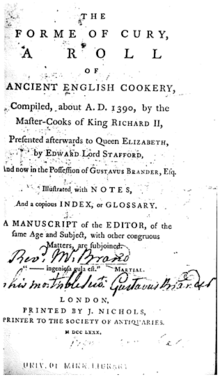The Forme of Cury

The Forme of Cury (Method of Cooking, cury being from French cuire: to cook)[1] is an extensive mediaeval recipe collection of the 14th century in the form of a roll.[2] Its authors are given as "the chief Master Cooks of King Richard II". The modern name was given to it by Samuel Pegge, who published an edition of it in 1780 for the curator of the British Museum, Gustavus Brander.[2] This name has since come into usage for almost all versions of the original manuscript. Along with Le Viandier, it is the best-known medieval guide to cooking.
The roll was written in late Middle English (c. 1390)[2] on vellum and details some 205 recipes (although the exact number of recipes varies slightly between different versions).
Sample recipe
The following is an example of a recipe taken from Pegge's 18th-century edition of the roll:
- SAWSE MADAME. XXX.
- Take sawge. persel. ysope. and saueray. quinces. and peeres, garlek and Grapes. and fylle the gees þerwith. and sowe the hole þat no grece come out. and roost hem wel. and kepe the grece þat fallith þerof. take galytyne and grece and do in a possynet, whan the gees buth rosted ynouh; take an smyte hem on pecys. and þat tat is withinne and do it in a possynet and put þerinne wyne if it be to thyk. do þerto powdour of galyngale. powdour douce and salt and boyle the sawse and dresse þe Gees in disshes and lay þe sowe onoward.
In modern English:
- SAUCE MADAME. 30.
- Take sage, parsley, hyssop and savoury, quinces and pears, garlic and Grapes, and stuff the geese therewith, and sew the hole that no grease come out, and roast them well, and keep the grease that falleth thereof. Take galyntine[lower-alpha 1] and grease and add in a posset; when the geese be roasted enough; take and smite [cut] them into pieces, and that that is within and add in a posset and put therein wine if it be too thick. Add thereto powder of galingale, powder-douce and salt and boil the sauce and dress the Geese in dishes and lay the sauce onward.[3]
Modern recreations
The Café at the Rylands, in Manchester's John Rylands Library, cooked Tart in Ymber Day, Compast, Payn Puff, Frumenty and Gingerbrede, accompanied by Piment (spiced wine), for invited guests in 2009.[4]
Notes
References
- ↑ "Thys fourme of cury ys compyled of þe mayster cokes of kyng Richard þe secund ... by assent of Maysters of physik and of phylosophye".--"Things sweet to taste: selections from the Forme of Cury". 1996 ISBN 0-86373-134-1
- 1 2 3 Wright, Clarissa Dickson (2011). A History of English Food. Random House. pp. 46, 50–52. ISBN 978-1-905-21185-2.
- ↑ As cooked by Clarissa Dickson Wright on the BBC Four show Clarissa and the King's Cookbook
- ↑ "Oldest English recipes cooked up at John Rylands". Manchester University. 4 December 2009. Retrieved 6 April 2015.
External links
- The Forme of Cury at Project Gutenberg, a transcription
- page images of the 18th century edition
- Text, links and modern versions at the Foods of England project
- Pygg in sawse sawge (British Library)
- index to the images of Forme of Cury (English MS. 7), scanned and put online as part of the Rylands Medieval Collection; John Rylands Library
- English MS 7, Forme of Cury; John Rylands Library